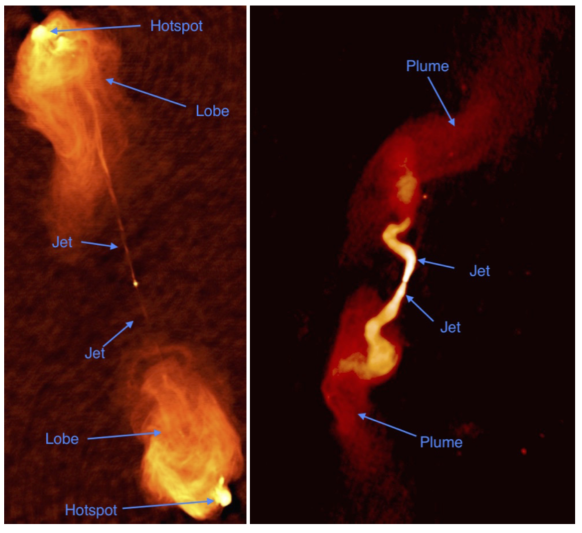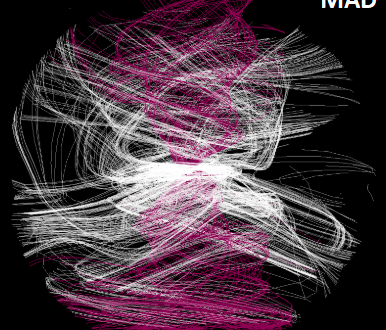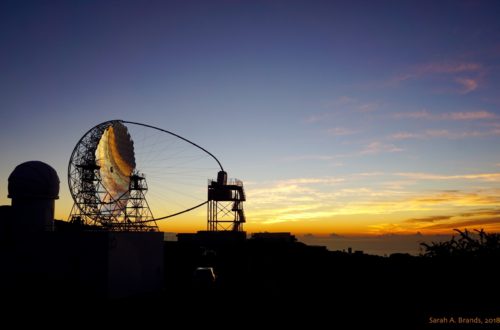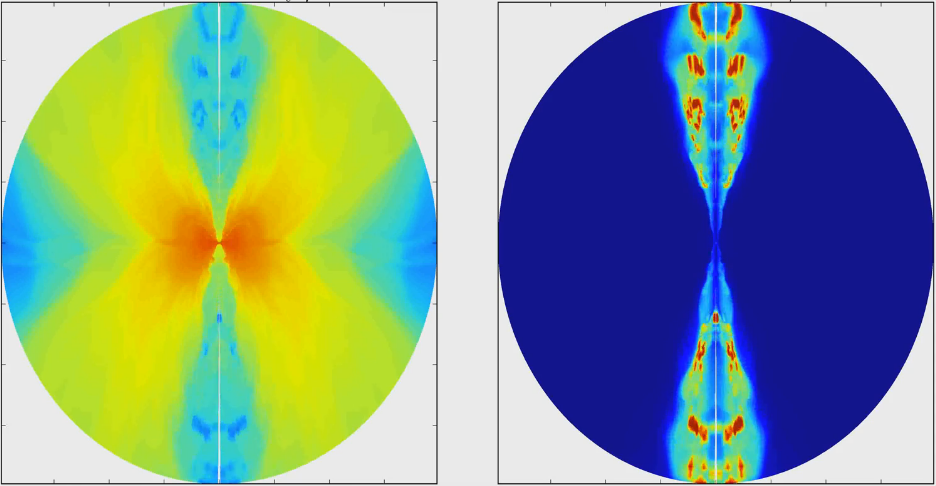Hi, my name is Gibwa Musoke. I recently joined Sera’s group as a postdoc. I conduct supercomputer simulations of the powerful fast-moving outflows, called jets, associated with active galactic nuclei (AGN). AGN are highly energetic and very bright compact regions at the centres of some galaxies, and are powered by black holes `feeding’ at the galactic centres as shown in Figure 1.
Research Interests
I am primarily interested in investigating how the jets interact with their environments at large distances from the centres of their host galaxies, and additionally, how the conditions in their environments influence the evolution of the jets. I conduct high resolution hydrodynamic simulations using the FLASH magneto-hydrodynamics code (Fryxell et al., 2000) to model the large-scale propagation of the jets. Comparing the simulations with observational data can provide insights into the physical processes behind the large scale jet propagation, and help to explain the detailed interactions behind the amazing astronomical images of these jets, such as those shown in Figure 2.

What are jets and how are they formed?
It is now believed that a black hole lies at the centre of all massive galaxies. These black holes are not just massive, but supermassive, with masses ranging from millions to billions of times the mass of our sun. The activity associated with the central black hole `feeding’ on, or accreting, the surrounding material in the galaxy is thought to be responsible for driving the jets.
The black hole accretes the galactic material caught in its immense gravitational potential. This material orbits the black hole, before eventually falling onto it- much like the action of water swirling around a plug hole. The material being accreted forms a disk around the black hole- the accretion disk, as shown in Figure 1. The disk material heats up and generates large amounts of electromagnetic radiation.
In some cases, a small fraction of the material being accreted is ejected from each face of the accretion disk. This ejected material forms jets that are launched along the rotation axis of the black hole and travel away from it. These jets are relativistic- they are launched with velocities as large as 99% of the speed of light! The jets produce additional electromagnetic radiation and are some of the most powerful, sustained sources of energy in the Universe. The centres, or nuclei, of galaxies can drive jets for periods spanning tens to hundreds of millions of years!
The jets are associated with emission over a wide range of frequencies across the electromagnetic spectrum, and typically emit radiation at radio, optical, X-ray and gamma-ray frequencies. Not all AGNs have jets and only around 10-15% of observed AGNs display these jets, which radiate strongly at radio frequencies. AGN that display these jets are the focus of my research, and two examples are shown in Figure 2.

Energy transport: How, where and how much?
The length of a jet can vastly exceed the size of its host galaxy, often propagating hundreds or even thousands of kiloparsecs away from the galactic centre. These distances are equivalent to millions of light years. The jets transport vast amounts of energy from the central regions of their host galaxies, and deposit this energy into the surrounding interstellar medium (ISM) and intracluster medium (ICM); the ambient gas filling the regions between the stars in galaxies, and the tenuous gas permeating the regions between galaxies in clusters respectively. The accretion process at the galactic nucleus and the energy deposited by the jets have a profound effect on the heating and cooling of the gas in these regions.
One key focus of my research concerns investigating the interactions of jets with their environments on kiloparsec length scales, focusing specifically on the energetics of the jets as they propagate through the ICM. I conduct simulations in order to determine how effective jets with various powers, velocities and densities are at depositing their energy into the ICM, where they deposit this energy and how effectively they heat the ICM.
Radio morphology: The strong, the weak and the unique
Images of the strong radio emission associated with jets reveal a range of interesting shapes and features as shown in Figure 2. The radio morphology of the jets- the shape and features of their strong radio emission, can be attributed to both the power of the jets and the conditions in their environments.
Powerful jets
Powerful jets typically remain fairly straight and well collimated (focused) along their lengths, and typically terminate abruptly as shown in the left image of Figure 2. Compact regions of intense radio emission, hotspots, mark the termination points of these jets. The hotspots are also sites of intense particle acceleration in the jets. Beyond this termination point the jet material slows significantly, flows back alongside the collimated jet flow and inflates lobes of turbulent jet material. These high powered jets are brightest at their leading edges- the regions furthest away from their host galaxies.
Weak jets
Weaker jets on the other hand remain less strongly collimated and transition into diffuse plumes as shown in the right image of Figure 2. The jets are typically brightest closer to their host galaxy and the plumes often display significant bending along their lengths. These jets do not display hotspots.
Some rather strange jets
The interactions between jets and their environments can lead to striking, unique and distorted jet morphologies. Jets can display large scale bending, and in some extreme cases, interactions with their surroundings can cause the jets to travel along some rather strange paths! Two examples of jets with striking radio morphologies are NGC 6109 and 3C 75, shown in Figures 3 and 4 respectively. NGC 6109 shows an extreme case of jet bending. The jet propagating towards the right of Figure 3 displays a relatively straight trajectory, while the jet on the left appears to continuously bend, forming a loop or `doughnut’ structure. 3C 75 shows a striking example of a jet-on-jet collision, with jets from two AGN interacting significantly.

The radio morphology of these jets, and indeed most jets, can be used to probe the nature of their environments; providing insights into the large scale motions of their host galaxies and revealing the presence of strong variations in the pressure and density of the ICM.
Simulating colliding jets
3C 75, shown in Figure 4, is a rare example of colliding jets. The jets are launched from two host galaxies that are in close proximity to each other, separated by only 8 kiloparsecs (or about 26 thousand light years). The galaxies are in the process of merging.

The jets on the right hand side of Figure 4 show a strong interaction, and appear to collide and merge, widening after the point of collision and transitioning into diffuse plumes. On the left of the figure a weaker interaction is observed, the jets bend and subsequently widen into plumes which interact with each other. All the jets in 3C 75 are observed to bend preferentially towards the top left corner of Figure 4, and this large scale bending is thought to be due to the host galaxies moving rapidly through the ICM with a velocity of 1200 kilometres per second (Hudson et al., 2006), that’s about 4.3 million kilometres per hour.

Collisions between jets are rare, and provide the opportunity to study jet interactions in some of their most extreme scenarios. Motivated by 3C 75, part of my research focuses on simulating colliding jets. An image showing a snapshot in time for one of the colliding jet simulations is given in Figure 5. As in 3C 75, the jet origins are separated by 8 kiloparsecs (26 thousand light years) and the snapshot shows the appearance of the jets roughly 43 million years into their evolution. The jets do not display the bending observed in 3C 75 as this particular simulation does not take into account the large scale motions of the nuclei moving through the ICM
The simulations are conducted in order to investigate the possible outcomes of jet-on-jet collisions- which conditions lead to the colliding jets bouncing off each other after the point of impact? Which conditions lead to the jets merging? How do the large scale motions of the host galaxies affect the jet collisions? And finally, what can all these things tell us about the jet interactions observed in 3C 75? Comparing the simulations with observational data will allow us to better understand the physics behind the rare and fascinating interactions observed in 3C 75.



